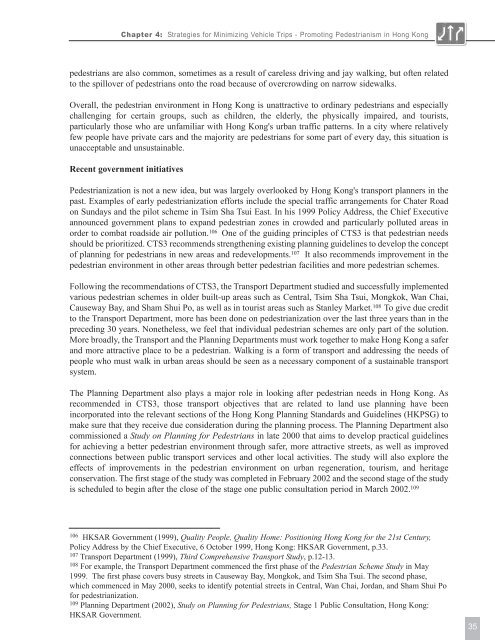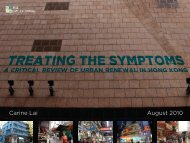Untitled - Civic Exchange
Untitled - Civic Exchange
Untitled - Civic Exchange
You also want an ePaper? Increase the reach of your titles
YUMPU automatically turns print PDFs into web optimized ePapers that Google loves.
Chapter 4:<br />
Strategies for Minimizing Vehicle Trips - Promoting Pedestrianism in Hong Kong<br />
pedestrians are also common, sometimes as a result of careless driving and jay walking, but often related<br />
to the spillover of pedestrians onto the road because of overcrowding on narrow sidewalks.<br />
Overall, the pedestrian environment in Hong Kong is unattractive to ordinary pedestrians and especially<br />
challenging for certain groups, such as children, the elderly, the physically impaired, and tourists,<br />
particularly those who are unfamiliar with Hong Kong's urban traffic patterns. In a city where relatively<br />
few people have private cars and the majority are pedestrians for some part of every day, this situation is<br />
unacceptable and unsustainable.<br />
Recent government initiatives<br />
Pedestrianization is not a new idea, but was largely overlooked by Hong Kong's transport planners in the<br />
past. Examples of early pedestrianization efforts include the special traffic arrangements for Chater Road<br />
on Sundays and the pilot scheme in Tsim Sha Tsui East. In his 1999 Policy Address, the Chief Executive<br />
announced government plans to expand pedestrian zones in crowded and particularly polluted areas in<br />
order to combat roadside air pollution. 106 One of the guiding principles of CTS3 is that pedestrian needs<br />
should be prioritized. CTS3 recommends strengthening existing planning guidelines to develop the concept<br />
of planning for pedestrians in new areas and redevelopments. 107 It also recommends improvement in the<br />
pedestrian environment in other areas through better pedestrian facilities and more pedestrian schemes.<br />
Following the recommendations of CTS3, the Transport Department studied and successfully implemented<br />
various pedestrian schemes in older built-up areas such as Central, Tsim Sha Tsui, Mongkok, Wan Chai,<br />
Causeway Bay, and Sham Shui Po, as well as in tourist areas such as Stanley Market. 108 To give due credit<br />
to the Transport Department, more has been done on pedestrianization over the last three years than in the<br />
preceding 30 years. Nonetheless, we feel that individual pedestrian schemes are only part of the solution.<br />
More broadly, the Transport and the Planning Departments must work together to make Hong Kong a safer<br />
and more attractive place to be a pedestrian. Walking is a form of transport and addressing the needs of<br />
people who must walk in urban areas should be seen as a necessary component of a sustainable transport<br />
system.<br />
The Planning Department also plays a major role in looking after pedestrian needs in Hong Kong. As<br />
recommended in CTS3, those transport objectives that are related to land use planning have been<br />
incorporated into the relevant sections of the Hong Kong Planning Standards and Guidelines (HKPSG) to<br />
make sure that they receive due consideration during the planning process. The Planning Department also<br />
commissioned a Study on Planning for Pedestrians in late 2000 that aims to develop practical guidelines<br />
for achieving a better pedestrian environment through safer, more attractive streets, as well as improved<br />
connections between public transport services and other local activities. The study will also explore the<br />
effects of improvements in the pedestrian environment on urban regeneration, tourism, and heritage<br />
conservation. The first stage of the study was completed in February 2002 and the second stage of the study<br />
is scheduled to begin after the close of the stage one public consultation period in March 2002. 109 35<br />
106 HKSAR Government (1999), Quality People, Quality Home: Positioning Hong Kong for the 21st Century,<br />
Policy Address by the Chief Executive, 6 October 1999, Hong Kong: HKSAR Government, p.33.<br />
107 Transport Department (1999), Third Comprehensive Transport Study, p.12-13.<br />
108 For example, the Transport Department commenced the first phase of the Pedestrian Scheme Study in May<br />
1999. The first phase covers busy streets in Causeway Bay, Mongkok, and Tsim Sha Tsui. The second phase,<br />
which commenced in May 2000, seeks to identify potential streets in Central, Wan Chai, Jordan, and Sham Shui Po<br />
for pedestrianization.<br />
109 Planning Department (2002), Study on Planning for Pedestrians, Stage 1 Public Consultation, Hong Kong:<br />
HKSAR Government.

















